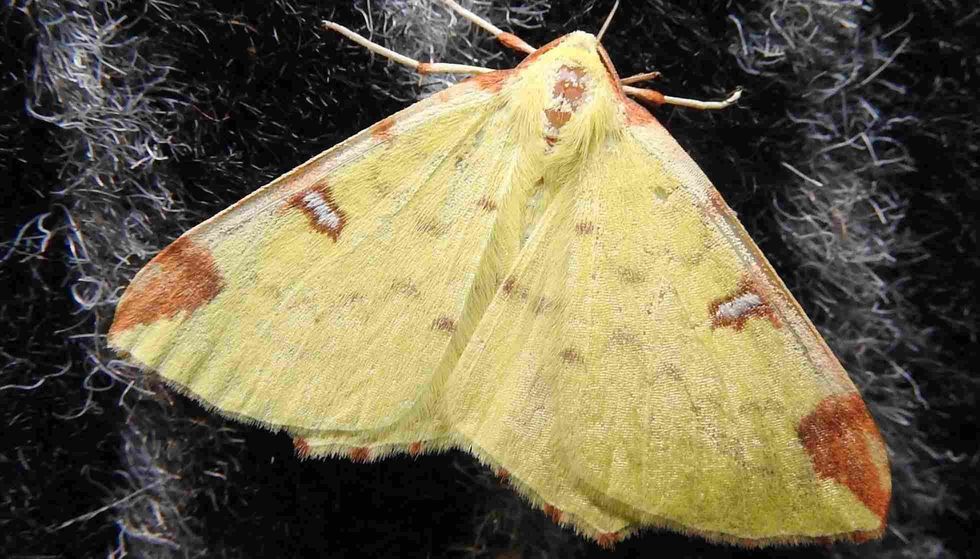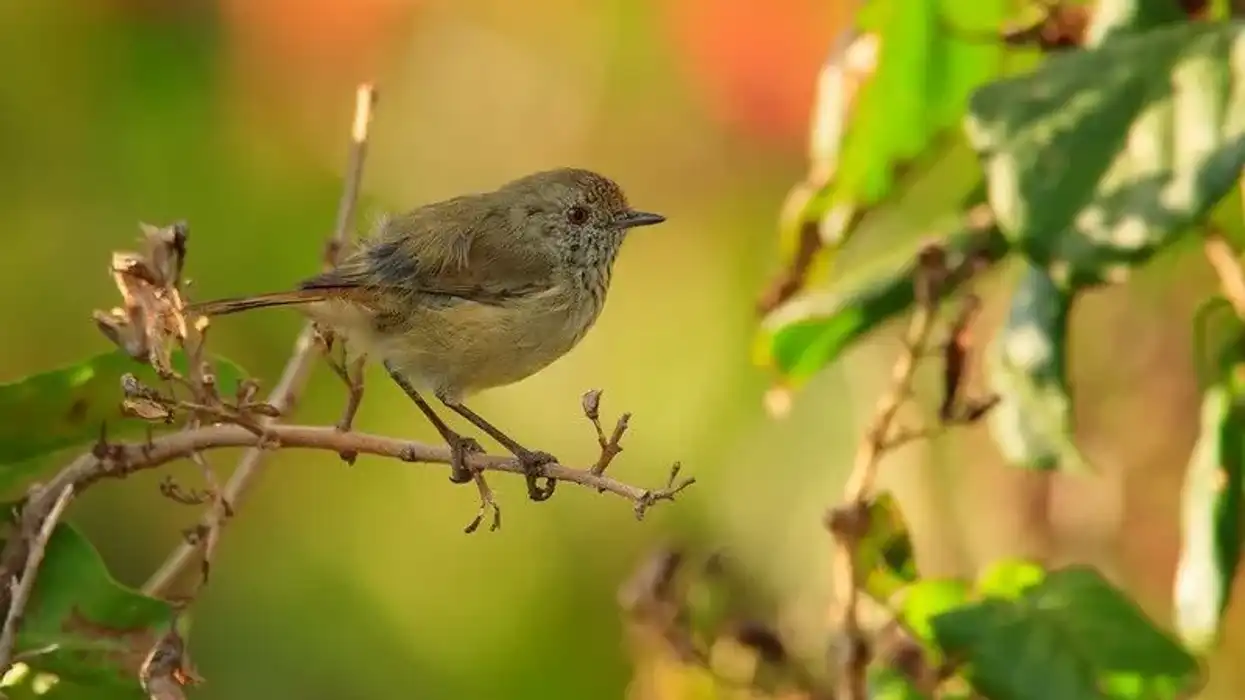The brimstone moth (Opisthograptis luteolata) is from the family Geometridae. It is found across western Asia and the Palearctic region. The habitat of the brimstone moth consists of grasslands, woodlands, and scrubs.
The breeding of the brimstone moth takes place by the male finding and chasing the mate until it falls to the ground. Depending on the species, the males tend to flap wings, move their antennae, and pheromones are released from the hair on the legs, thorax, wings, or abdomen.
The male then mounts the female. The mating takes place for a very short period of time. In some of the species, parthenogenesis is used to reproduce, that is, from unfertilized eggs, the caterpillars hatch.
This moth is a bright yellow colored with brownish patches on the forewing. It has a whitish dash or crescent on the edge of the fore wing.
The wings of this moth are quite angular. The larva of this moth is green or brown in color and has a horn on the back.
The caterpillars feed on trees, bushes including hawthorn, blackthorn, and fruits like apples, and willows. The wingspan of the brimstone moth ranges from 1.3-1.8 in (3.3-4.6 cm) but the flying speed of this brimstone moth is not known.
The brimstone moth is often confused with the brimstone butterfly but they are both separate species. The brimstone moth is known to be quite widespread in Britain and occurs in three generations that are overlapping in the south.
It is very gripping to learn about the Opisthograptis luteolata, commonly known as the brimstone moth and if you are interested, read about the hag moth and Io moth, too.
Brimstone Moth Interesting Facts
What type of animal is a brimstone moth?
The brimstone moth is a moth.
What class of animal does a brimstone moth belong to?
It is classified under the Insecta class.
How many brimstone moths are there in the world?
There is no estimation available for the global population of the Opisthograptis luteolata, the brimstone moth as it is commonly known. The brimstone moth is known to be quite widespread in Britain and occurs in three generations that are overlapping in the south.
Where does a brimstone moth live?
The population of the brimstone moth (Opisthograptis luteolata) is distributed across western Asia and the Palearctic region. It is not known whether this moth is endemic or not.
What is a brimstone moth's habitat?
The types of habitat that this moth inhabits include grasslands, woodlands, and scrubs.
Who does brimstone moth live with?
Not a lot is known about these insects being solitary or living in groups.
How long does a brimstone moth live?
The exact life expectancy of this brimstone moth (Opisthograptis luteolata) is unknown.
How do they reproduce?
In general, in a lot of species, the male finds and chases the mate until it falls to the ground. Depending on the species, the males tend to flap wings, move their antennae, and pheromones are released from the hair on the legs, thorax, wings, or abdomen.
The male then mounts the female. The mating takes place for a very short period of time.
In some of the species, parthenogenesis is used to reproduce, that is, from unfertilized eggs, the caterpillars' hatch.
The exact number of eggs laid by the brimstone moth is unknown, but it has been recorded that a single brood is produced every year or sometimes, three broods in two years and thus, adults of this species can be spotted on the wings around April to October.
The larva of this moth is green or brown in color and has a horn on the back.
What is their conservation status?
The status of the conservation of this insect is not known, but it is commonly found, especially in the UK, and is not thought to be endangered. According to The Wildlife Trusts, its conservation status is Common.
Brimstone Moth Fun Facts
What do brimstone moths look like?
The medium-sized brimstone moth tends to have bright yellow-colored wings with some small blotches that are brown on the forewing. It also tends to have a white-colored crescent or dash around the leading forewing edge.
The wings of this moth appear to be quite angular. This moth can be distinguished from the other yellow-colored moths because of its white patch. The larvae of this moth are green or brown in color and have a horn on the back.
How cute are they?
These insects are considered cute because of their color.
How do they communicate?
These moths communicate through various sounds.
How big is a brimstone moth?
The exact measurements of this moth are not known, but it is considered to be medium-sized. Its wingspan has a range of 1.1-1.7 in (28-42 mm). The wingspan of this moth can be similar to that of a banded tussock moth and has a smaller wingspan than a giant leopard moth.
How fast can a brimstone moth fly?
A moth, in general, is known to fly with average speeds of up to 33.5 mph (54 kph).
How much does a brimstone moth weigh?
The weight of this yellow brimstone moth (Opisthograptis luteolata) is unknown. Due to its small size, it's likely to be fairly negligible.
What are the male and female names of the species?
Males and females of this medium-large yellow moth species do not have any particular names.
What would you call a baby brimstone moth?
The babies of moths are in general referred to as caterpillars or larvae.
What do they eat?
The brimstone moth caterpillars feed on trees and bushes including hawthorn (Crataegus monogyna), rowan (Sorbus aucuparia), and blackthorn (Prunus spinosa), birch, apple, currant, and willow.
Are they dangerous?
The brimstone moth is not considered dangerous. Most of the species of moths are not harmful and some species might cause a very painful sting but cannot kill you.
Would they make a good pet?
Not much is known about keeping the Opisthograptis luteolata, the brimstone moth as it commonly known, as pets.
Did you know...
The first description of this yellow and brown moth species was done by Carl Linnaeus in the 10th edition of the Systema Naturae in 1758.
To attract moths and butterflies in your house garden, it is suggested that you plant nectar-abundant plants, shrubs, and climbing ivy for the moths to feed and also for overwintering insects.
There are around 300 geometrids species found in the United Kingdom.
The brimstone moth (Opisthograptis luteolata) is known to be one of the delicate species in its family and similar to a butterfly.
The most dangerous moth is known to be the puss caterpillar. The puss caterpillar is also referred to as asp caterpillar.
Other brimstone moth names include yellow moth.
The white patch or dash around the wing makes it easy to spot the brimstone moth. The adults of this species can be spotted with this on the wings any time around April to October.
What is the difference between a moth and a butterfly?
While members of the moths and butterflies family might look quite similar, there are certain differences between the two that can help you identify one from the other.
You can look out for the wings of the insect. While resting, the wings of the moths are open, whereas, butterflies tend to rest with their wings in a closed position.
Butterflies are known to be diurnal, that is, active during the day, whereas, the moths are nocturnal as they are active at night.
The antennae of the moth are shaped like a feather or leaf, whereas, that of the butterfly is long, eject and bare, and is club-shaped. The antennae of most of the members of the butterfly family also have a bulb at the end.
There are frenulums present in the moths, that is, a device that couples the wings together when flying, whereas, this is absent in the butterflies.
During the metamorphism from a caterpillar to a butterfly, a pupa of hardened protein is spun, whereas, the pupa of moth caterpillars is a silk pupa and is called a cocoon.
There might be some exceptions like the gypsy moth as the pupae of this moth is quite similar to that of a butterfly and a Parnassius butterfly makes a cocoon.
In general, moths are known to have furry and stockier bodies as compared to butterflies, as they have lean and smooth bodies.
Both the insects have adapted to have different eyes. The moths tend to have superposition eyes, whereas, the butterflies have apposition eyes. Superposition eyes reflect light at the same angle, whereas, the apposition eyes tend to work by collecting various images and putting them inside the brain.
It is believed that, in general, when compared to butterflies, moths tend to have paler colors and less prominent patterns.
How common are brimstone butterflies?
Brimstone butterflies are known to be widespread but are not really considered common. They may be common only during the spring season.
Here at Kidadl, we have carefully created lots of interesting family-friendly animal facts for everyone to discover! Learn more about some other arthropods from our emperor scorpion facts and black witch moth facts pages.
You can even occupy yourself at home by coloring in one of our free printable arthropods coloring pages.









